Ready to get into woodworking and take on some more challenging projects? You may want to level up your tools, too. But there are hundreds of equipment possibilities. So we decided to curate a quick rundown of the 13 best tools for your woodworking shop:
- Pocket Hole Jig
- Miter Saw
- Nail Gun
- Table Saw
- Band Saw
- Right Angle Clamps
- Benchtop Jointer
- Moisture Meter
- Automatic Center Punch
- Laser Level
- Wood Lathe
- Router
- 3-Phase Converter
Every one of these cool tools presents a new opportunity to elevate your skills and try out exciting new creations. So let’s get started and see what you can do with the 13 best woodworking tools you definitely want to buy.

1. Pocket Hole Jig
Joining boards together for a piece can be a complicated task. But pocket-hole joinery makes the process easier, faster, and more accurate. And a pocket hole jig is the tool to help you do it.
In pocket-hole joinery, you drill a hole at an angle through one piece. With your handy pocket hole jig, you just clamp it into place and it lines up your hole at the right angle for drilling. This shallow angle allows plenty of room for a screw to go through and attach to another piece. The whole assembly takes minutes.
A basic, single-hole jig should work fine to start. Later, if you find you’re drilling a lot of pocket holes, you might want to move up to a larger, multiple-hole, workbench-mounted jig.

2. Compound Miter Saw
We put a miter (sometimes spelled mitre) saw as an option on our recent list of essential woodworking tools for beginners. Truth be told, saying this is an essential tool may be an overstatement for beginners. But as you progress as a DIY woodworker, you’ll soon need the versatility of a good miter saw.
Anyone who has used an old crosscut hand saw knows that they are extremely inaccurate and very time-consuming. This tool solves both of those problems. After you buy one of these, you can drive a couple of nails into the wall of your shop and put the hand saw up there where it will probably stay for the rest of its life.
A compound miter saw is a circular saw on an arm that you can tilt and pivot to any angle for your woodworker needs. Then lower the arm through your workpiece to make the a straight cut or bevel cut.
The trickier the angle cut (think crown molding), the more you’ll want this equipment. It’ll save you lots of time and energy in measuring because you can lock in the blade at the angle you want. The only drawback is the diameter of your saw blade limits the depth and width of the wood you can cut. A 12” blade should do the trick for most beginner to intermediate projects.
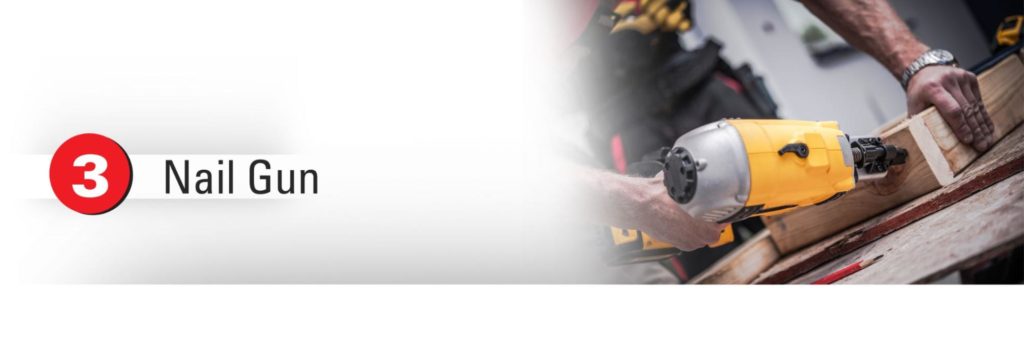
3. Nail Gun
A throbbing red, hammered thumb may be a comedy cartoon cliche, but it’s not funny when it really happens and can hurt the motivation to work as a DIY woodworker. If you do a lot of nailing, you can avoid this painful fate with a nail gun. You can also prevent repetitive stress on your elbow.
A nail gun helps you place more nails in the right places quickly and safely than what you can get with hand tools. Just place it against your workpiece and pull the trigger.
Perhaps you already have an air compressor for another piece of equipment? If so, a pneumatic nail gun is a great choice. It uses the force of air to drive the nails, so there’s no separate motor or battery. That means a pneumatic gun is lighter and easier to handle. If portability is important for your projects, then consider a cordless nailer.
Outside your power choice, you also need to choose between framing, finishing, and brad nailer-type guns. Framing nail guns are the most powerful. They’re good for driving long nails through heavy-duty heavy construction materials. Finishing and brad nail guns are better suited to the more precise work you’re probably doing in your shop. The main difference between the two is the size of the nail accommodated. Finishing nailers are for the larger, 14- to 16-gauge nails, whereas a brad nail gun is for smaller 18-gauge nails and more delicate work.

4. Table Saw
A table saw is ideal for making many types of larger cuts at a variety of angles. It’s like a miter saw, but with the blade mounted under the tabletop. You can do most of the same cuts you might do with a miter, too.
You can tilt the blade, but you can’t rotate it. However, you can use a miter gauge to do your angle cuts. The biggest advantage of the table saw over the miter is that you’re pushing your workpiece against the blade rather than the other way around. So you’re not limited in the width of the wood you can cut.
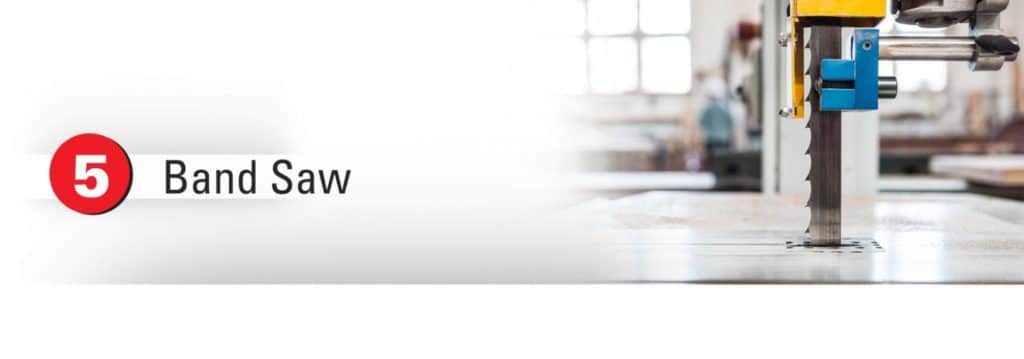
5. Band Saw
A band saw (often seen as one word, bandsaw) is excellent for making smooth, intricate cuts. Think curves, circles, etc. The wheels inside this machine rotate a thin, toothed metal blade (the band). You move your workpiece against the blade, allowing you to work with as much precision as your skills allow.
The combination of power and a thin, sharp blade means a bandsaw can cut all kinds of materials, including metal.
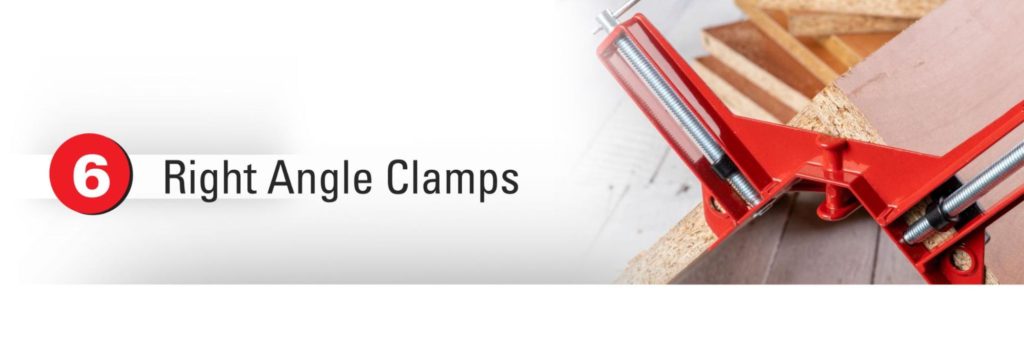
6. Right Angle Clamps
Let’s get back to the challenge of joining two pieces of wood. How do you keep those two pieces together at the proper angle while you work?
The answer is a right-angle clamp. This L-shaped clamp and frame give you a 90-degree angle you can count on. Just tighten the spindle to secure the clamp to your workpieces so you can keep both hands free. It’s a fast and easy way to be confident you’re connecting your pieces correctly.

7. Benchtop Jointer
Even with the best right angle clamp, you might struggle to get the right fit between two boards if you don’t have straight edges. The problem? Warping, bowing, or otherwise uneven edges on your workpiece. These imperfect surfaces can cause all kinds of trouble.
That’s when a benchtop jointer can come to the rescue. You can cut those imperfections right out of your boards and save yourself some frustration with this practical power tool. A jointer is a type of planer that uses rotating blades that sit between two tables. Raise or lower the infeed table vs. the blades to set the level of cut. You push the workpiece against the blades to make your newly smooth flat board. Then you’re ready to put the pieces together successfully!

8. Moisture Meter
A moisture meter isn’t a tool for cutting, smoothing, or fastening. But that doesn’t mean you don’t need one around.
Moisture content is a key consideration in woodworking or carpentry. Wood is hygroscopic, meaning that it absorbs or adsorbs ambient moisture. Wood’s moisture content will equalize with what’s around it. So if the wood you’re using hasn’t already acclimated to its surroundings, it may get wetter or dryer. Wood swells and warps as it takes on moisture, and it cracks and shrinks as it dries. Neither of these developments is good for the quality of your projects.
That’s why you need a moisture meter to check your wood before you begin. You’ll want a pinless meter for woodworking, which determines moisture content via electrical impedance. Other types use pins that poke holes in the material, which is something you want to avoid.
Moisture meters are relatively inexpensive. The most accurate meters–measuring to within 0/1%–can cost several hundred dollars. But you can get one that’s only a bit less precise, at 1 to 2%. And that will do the trick, at a more reasonable cost that’s well worth your money.
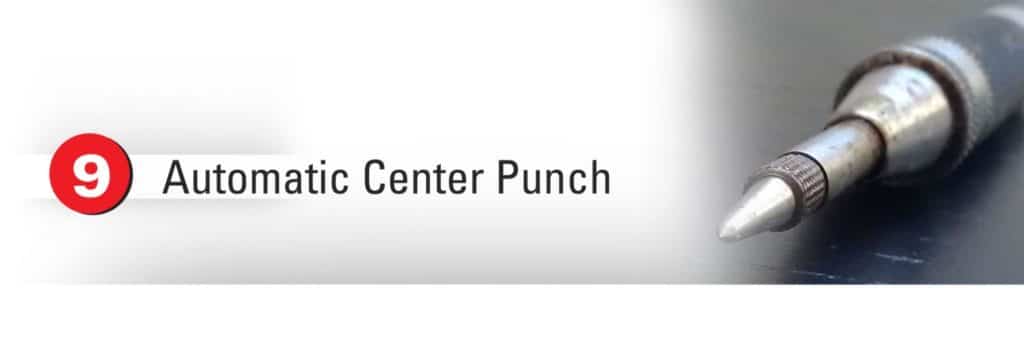
9. Automatic Center Punch
An automatic center punch is among the more humble tools on our list. You don’t have to choose between corded or cordless variations for this tool, but once you’ve lived with one you’ll never want to live without one.
This hand tool does the same thing a regular center punch does: It creates a dimple in your workpiece to mark precise spots for drilling. But the automatic center punch replaces the need for a hammer with a spring-loaded mechanism. Press the punch to trigger the release of the spring and drive the punch, generally made of the same tool steel drill bits are made of, into the piece.
It’s simple, fast, and exact. Now you know right where to drill! It’s also the most inexpensive tool on this list coming in right $5 at most stores or on Amazon.
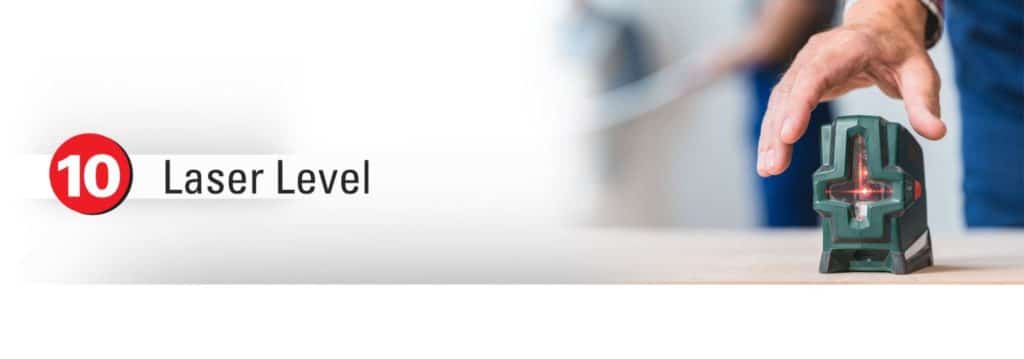
10. Laser Level
Your old bubble level may work fine for some woodworking projects. But the more frequent and varied your work, the more you’ll appreciate a laser level.
Laser level devices project a leveled red or green line across a horizontal or vertical plane. They’re excellent when you need a level reference point over a larger distance than a standard level can accommodate.
A laser level also offers some added capability. Some models are auto-leveling. Others can project a cross-line at a perfect 90 degrees, which is helpful for advanced woodworking, including cabinetry. And as cool as these tools are, they aren’t all that expensive (a fully-featured auto-leveling cross line model runs about $150). You won’t regret springing for a high-quality device.

11. Wood Lathe
Chair legs. Bowls. Baseball bats. If you’re making anything like this, you’re turning wood. And for that, you need a wood lathe to do these projects
A wood lathe spins wood at high speed and rapidly shapes it by using a chisel set or gouge tool. Besides many cylindrical wood products, wood lathes are also ideal for making bowls or knobs for drawers. In a nutshell, anything round calls for a wood lathe in your woodshop or on your workbench.
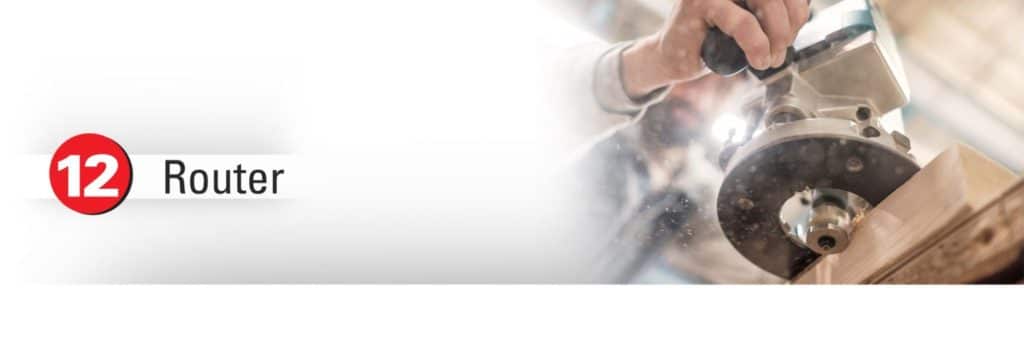
12. Router
A router is another tool that uses a motor to rotate at high speed (over 20,000 rpm, in fact). But whereas the lathe spins a workpiece, a router spins a bit/chuck that does the work.
A router is a perfect tool for a huge variety of decorative designs. There are all kinds of different router bits for different cuts and shapes–trimming, rabbeting, cove, dovetail, chamfer, and more. You can buy the bits as your projects warrant. Carbide bits help you make cleaner cuts than steel ones. They’re also more expensive up front, but they stay sharp better, so keep that in mind.
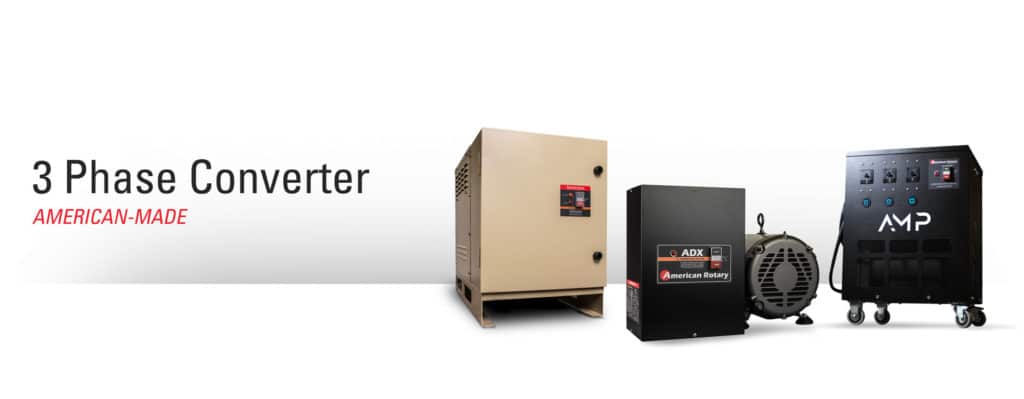
13. 3 Phase Converter
With several of the tools on this list—particularly the router, lathe, jointer, band saw, and table saw— or with other tools you have in your shop that weren’t mentioned in this list like a drill press, variable speed grinder or belt sander, or your dust collection system, the higher the power and torque, the better. If you want that power and you want the equipment to last, you should consider investing in three-phase equipment.
But chances are, you don’t have industrial three-phase electricity service running to your shop (if you do, congratulations!). Fortunately, you can still run your powerful 3-phase tools, plus any single-phase equipment at the same time.
How? By installing a rotary three-phase converter. USA-made American Rotary phase converters can deliver balanced 3-phase for your shop. Contact us for help sizing a phase converter for your current and future demands. You can also explore American Rotary phase converters for woodworking here.



